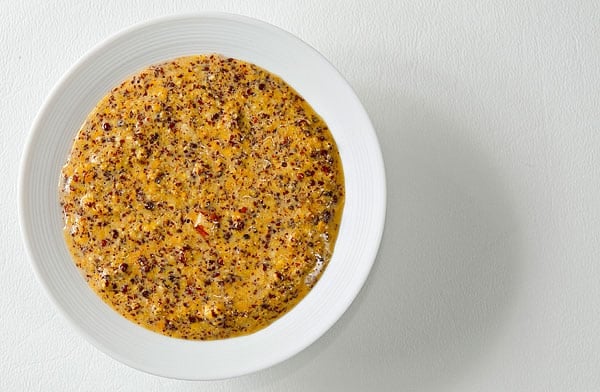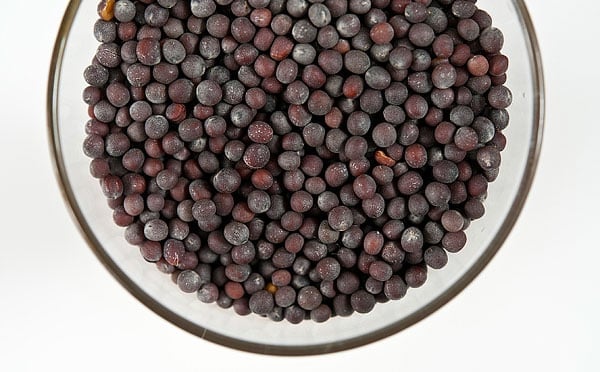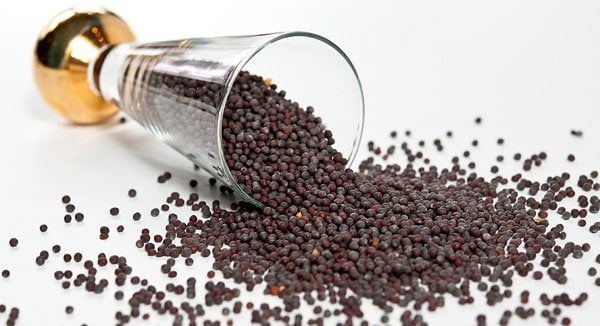As an Amazon Associate I earn from qualifying purchases.

What do you mean you can make mustard at home? It was all I could do to say, “Uh… how did you think it was made? By mustard elves under a tree?” Thankfully, I am older and nicer than I once was. Instead, I said, “Why yes, and it is really, really easy to make.”
I had this conversation with another food blogger, and I tell you this because even for even a food person to not know how to make mustard tells me that it must appear to be magic to most people. But I gotta tell ya folks, it ain’t. If you have mustard seed and water, you can make mustard. It’s that easy. And pretty much every culture in the Northern Hemisphere has done so: Mustard is to the North what chiles are to the tropics.
Mustard is a condiment of a thousand faces. Some are smooth, others almost entirely made from barely cracked seeds. Vinegar is often used, but wine, beer, grape must, and even fruit juices are used to moisten the seeds. Sweetness is usually achieved by adding honey; an American “honey mustard” can be a 1:1 ratio of mustard to honey. A Bavarian sweet mustard, however, uses only sugar and water: no acid, no honey. Italians put fruit preserves in their mustard, a practice I wholeheartedly endorse.
Mustard is one of Europe’s few native spices, although mustard also has been used in Chinese cooking for around 2,500 years as well. Ancient Rome was quite the hotbed of mustard-making, and it is Rome that gives us our name for mustard: It is a contraction of mustum ardens, or “hot must;” the Romans often added crushed mustard seeds to unfermented crushed grapes. I’ve recreated a different Roman recipe for mustard that uses almonds, pine nuts, mustard seed and red wine vinegar. The ferocious bite of this mustard — it should be made with black mustard seeds, the hottest variety — is mellowed by the richness of the nuts. It’s a great accompaniment to roasted meats.
The basic idea behind making mustard is this: Grind seeds and add cool liquid. At its most basic, this is all mustard is. Both Chinese and English mustard (think Coleman’s) is nothing more than water and mustard powder. But there are some things you need to know to make great mustard.
First, you need cold liquid. What gives mustard its bite is a chemical inside the seeds reacting with cool or cold liquid. You also need to break the seeds to get at the fiery chemical — it’s like cutting an onion. Heat damages this reaction, however, so to make a hot mustard use cold water, and warm water for a more mellow mustard. Mustard sauces lose punch when long-cooked, and should always have a little extra fresh mustard tossed in at the end of cooking.
This reaction is volatile, too. Left alone, your mustard will lose its bite in a few days, or in some cases even hours. But adding an acid, most often vinegar, stops and sets the reaction in place — this is precisely what happens with horseradish as well. Adding salt not only improves the flavor, but also helps preserve the mustard, too.
Once made, mustard is nearly invulnerable to deterioration. Mustard is one of the more powerful anti-microbial plants we know of, and, considering it is mixed with vinegar and salt, it becomes a heady mix no wee beastie can survive in. It is said that mustard will never go bad, although it can dry out.
You have three choices when it comes to which variety of mustard seed you use: White, brown and black. White mustard undergoes a different, milder reaction than do brown or black mustards, which are far zingier. American yellow mustard is made with white mustard seed and turmeric, brown mustards are in most of your better mustards, and black mustard is used in hot mustards or in Indian cuisine.

Incidentally, the wild mustard all over California is black mustard. You can thank Father Junipero Serra for that one: He used mustard, which grows like a weed, to mark his travels in Alta California 250 years ago.
The famous Grey Poupon mustard — Dijon has been a center of mustard-making for nearly a millennia now — is traditionally made with stone ground brown mustard and verjus, the tart juice of unripe grapes. I prefer this style of mustard, and most of my homemade mustards are grainy like Dijon. I grind my seeds with a spice grinder, but you could get all old school and use a mortar and pestle.
The best mustards, in my opinion, combine brown or black mustard seeds with yellow mustard powder: The two sets of chemical reactions complement each other and made a more complex mustard.
Always add water or a non-acidic liquid first, let the mixture sit for 10 minutes or so, then add the acid (vinegar, verjus, lemon juice, etc).
Add salt to taste, but it’s typically about 1 to 2 teaspoons per cup of prepared mustard.
Finally, let your mustard set in the fridge or in a cool place for at least a day before you serve it. Bitterness is a byproduct of the mustard reaction, but that bitterness fades after a day or so. Pure mustards can be kept at room temperature, but mustards with other ingredients, like the Roman nut mustard I mention above, should be kept in the fridge.
So there you have it. Easy-peasy. Now you really have no reason to ever buy mustard again.

[recipe_name]Basic Country Mustard[/recipe_name]
[summary]What could be easier than making your own mustard? No, really. It is stupid easy. Grind some mustard seeds, mix with mustard powder and some liquid and you’re done. There is no earthly reason to ever buy mustard once you learn this basic recipe. Endless variations exist. Change the liquid and you change the mustard. Grind the mustard seeds a lot or a little and you change the texture — or skip the whole seeds altogether and use just mustard powder.
Which type of mustard seed do you use? Yellow is what we Americans are most used to, but brown is spicier, more mustardy. Black mustard is stronger still, and it grows wild over much of North America; gather the seeds in late summer or early fall.
Want herbs in there? Go for it. Like honey mustard? Pour some in. Want your mustard even spicier? Add chiles or freshly grated horseradish. I even made a mustard with fresh grape juice from my backyard wine grapes. I called it Deep Purple. Weird-looking, but delicious.
The one caveat to making mustard at home is to wait. You cannot eat it the day you make it. Mustard needs to marinate to dissipate its bitterness. Try it: Eat a little dab right after you make it, then a day or two later. The difference is dramatic.[/summary]
[yield]Makes about 1 cup.[/yield]
Prep Time:[preptime time=12H] 12 hours[/preptime]
- [ingredient][amount]6 tablespoons[/amount] [item]mustard seeds[/item] [/ingredient]
- [ingredient][amount]1/2 cup[/amount] [item]mustard powder[/item] [/ingredient]
- [ingredient][amount]3 tablespoons[/amount] [item]vinegar[/item] (cider, white wine or sherry) [/ingredient]
- [ingredient][amount]1/2 cup[/amount] [item]white wine[/item] or water [/ingredient]
- [ingredient][amount]2 teaspoons[/amount] [item]salt[/item] [/ingredient]
OPTIONAL
- [ingredient][amount]2 tablespoons[/amount] [item]honey[/item] [/ingredient]
- [ingredient][amount]2 tablespoons[/amount] grated [item]fresh horseradish[/item] [/ingredient]
- 1/4 cup minced fresh herbs (really any kind)
[instructions]
- Grind the whole mustard seeds for a few seconds in a spice or coffee grinder, or by hand with a mortar and pestle. You want them mostly whole because you are using mustard powder, too.
- Pour the semi-ground seeds into a bowl and add the salt and mustard powder. If using, add one of the optional ingredients, too.
- Pour in the vinegar and wine or water, then stir well. When everything is incorporated, pour into a glass jar and store in the fridge. Wait at least 12 hours before using. Mustard made this way will last a year in the fridge.
[/instructions]




Hey Hank,
You note to always add the water first, then the recipe states to add water and vinegar at the same time. Unless I’m reading it wrong?
Anyway, just coming back to this recipe after a few years. I made a whole bunch in different ways, relying on the information here, and one a bit different. They were pretty tasty, but a couple I didn’t like as much, as happens, but after six months or so in the fridge, one of those became my favourite. I assume this is from it fermenting slowly. Prior to that one striking ahead, one I made by trying to lacto-ferment the seeds on the benchtop was the winner. Not sure how that worked, but it was a long, slow ferment with the ratio of an olive brine. I don’t know what happens with the reaction that generates the heat, but it still had some warmth and was very complex. I drained the seeds, then blitzed them using brine to get the right consistency along with vinegar. Anyway, long story… seems there’s a role here for fermentation adding to the story beyond the first few days.
Dear Hank – your education was not wasted! Thank you for your erudite and creative explanation of mustard-making.
This is my question: all the recipes call for mustard powder. Regarding the seeds, we have white, brown, and black. But, regarding the powder, where does it come from? Can you just make your own from seeds using a spice grinder?
Thank you sir.
A. Dias: Yep. You can. I’ve used all three seeds to make the powder.
this tastes great, but I guess I didn’t pulverize the seeds enough. After two weeks, they are crunchy. Am I able to put this in my food processor and save the batch?
CEO: Yep, you can do that.
Great information – thank you!!!
“Hot” Mustard was bought by our club by mistake, should have been “Mild”. We have a 2kg bottle of it, and don’t want to waste money by dumping it. Is there a way of Toning down the “Hot-ness”. I see sometimes honey can be added, any other suggestions, thanks.”
Geraldine: Nope. Sorry!